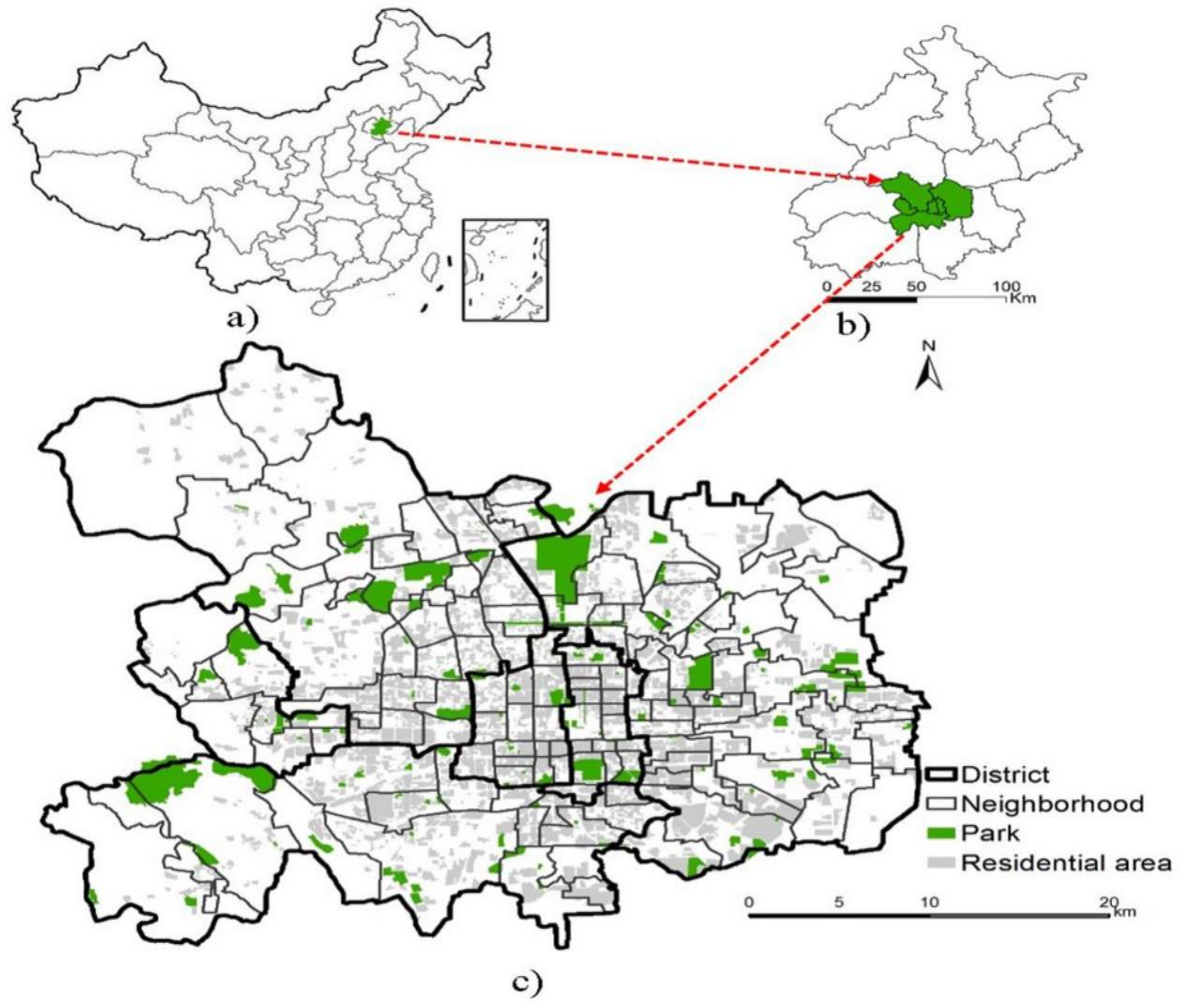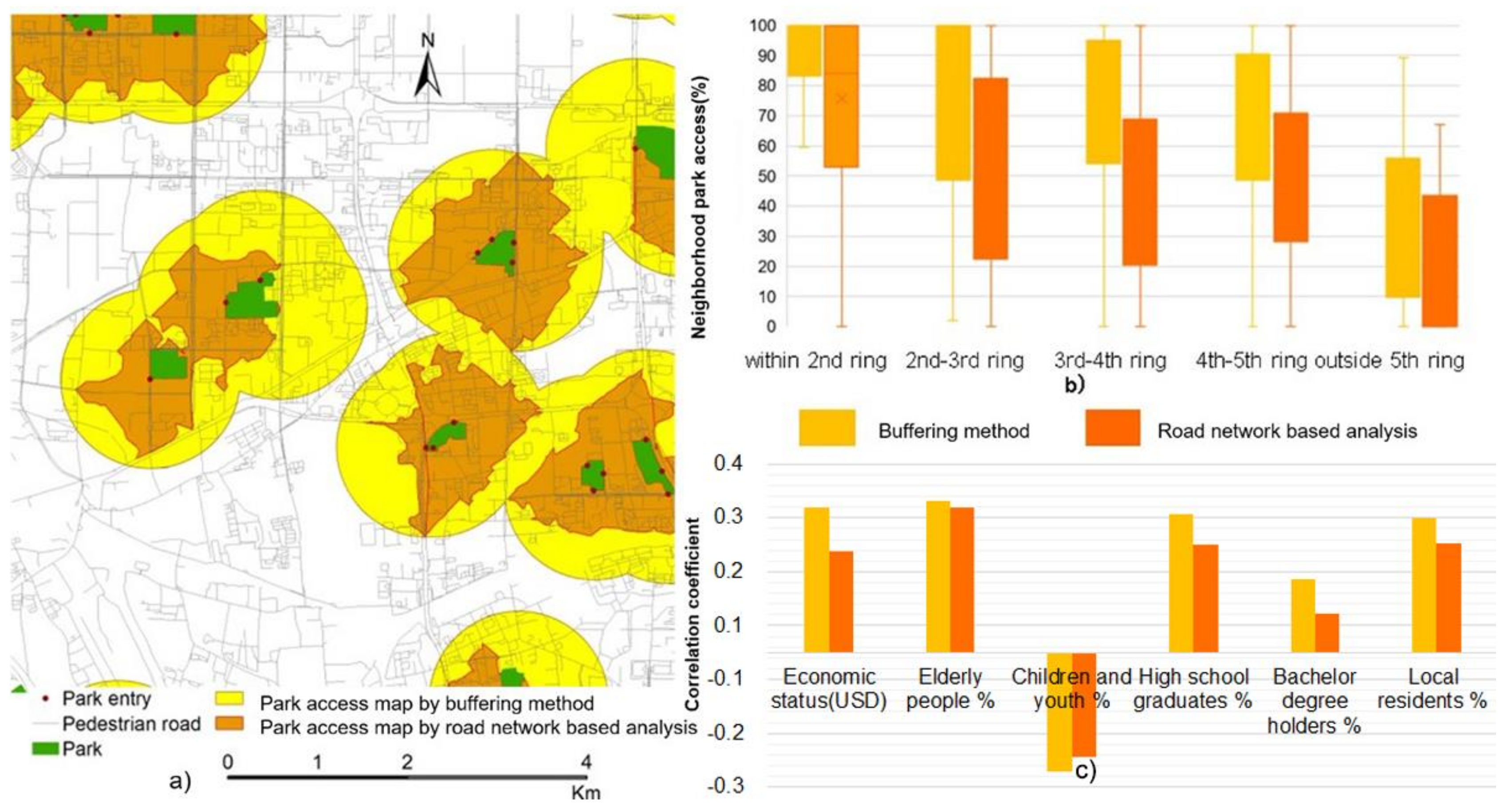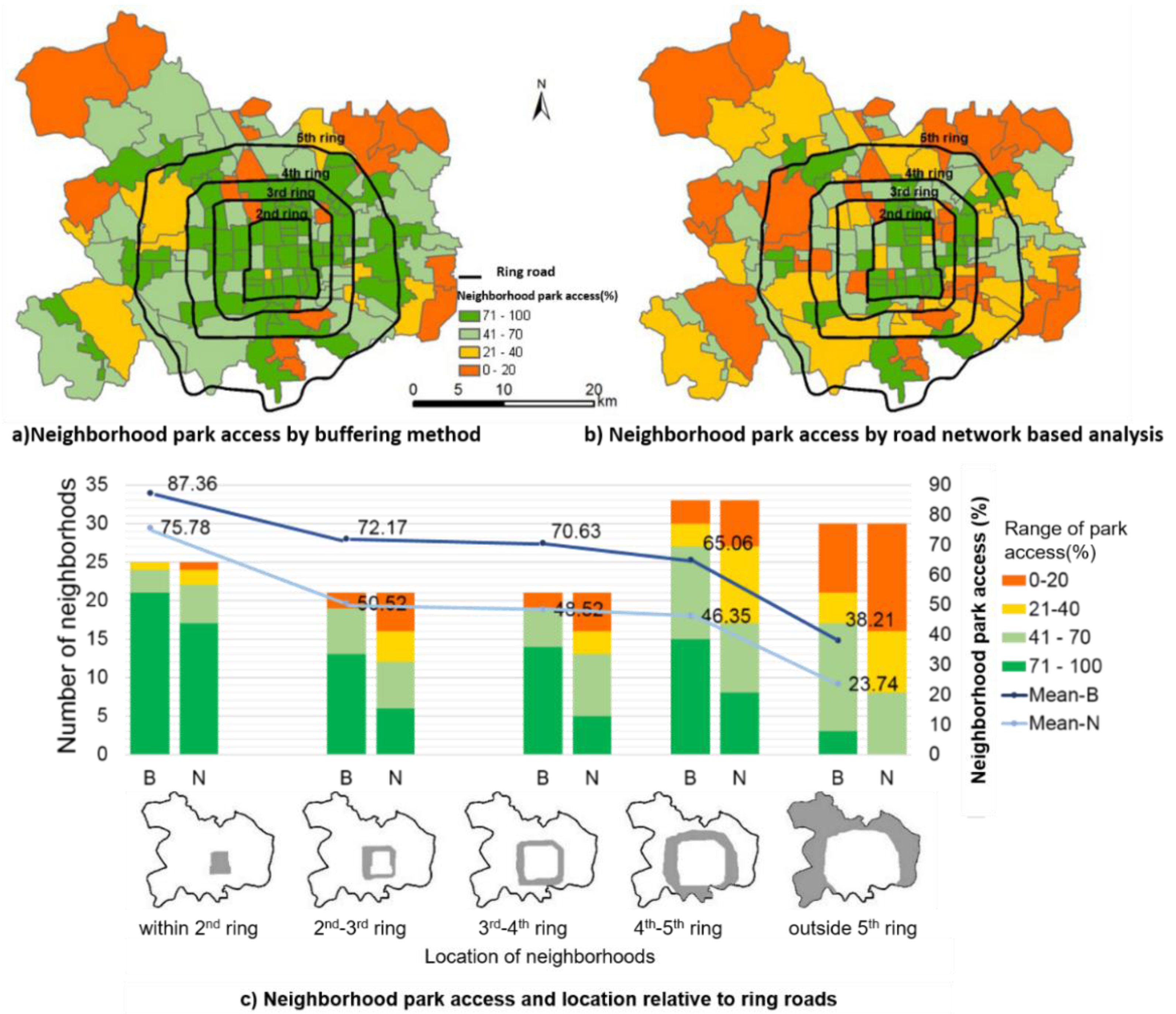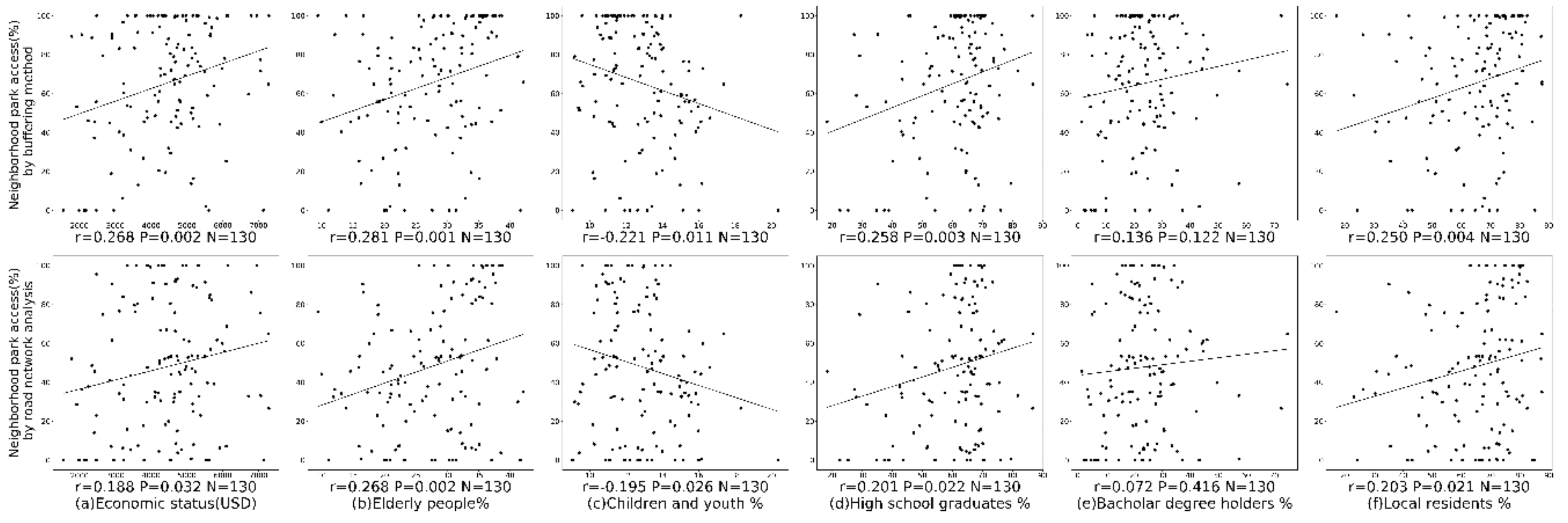Contrary to Common Observations in the West, Urban Park Access Is Only Weakly Related to Neighborhood Socioeconomic Conditions in Beijing, China
Abstract
:1. Introduction
2. Materials and Methods
2.1. Study Area
2.2. Data
2.3. Analysis
3. Results
3.1. Comparing the Buffering Method and Road Network-Based Analysis
3.2. Spatial Patterns of Park Access in Beijing
3.3. Relationships between Neighborhood Park Access and Socioeconomic Conditions
4. Discussion
4.1. How Does the Neighborhood Park Access Vary Spatially across the City of Beijing?
4.2. How Is Park Access Related to Neighborhood Socioeconomic Conditions?
4.3. How May Urban Planning Practice Affect the Association between Park Access and Neighborhood Socioeconomic Conditions?
4.4. Comparing the Buffering Method and the Road Network-Based Analysis
4.5. Future Research
5. Conclusions
Supplementary Materials
Acknowledgments
Author Contributions
Conflicts of Interest
References
- Kaczynski, A.T.; Koohsari, M.J.; Stanis, S.A.W.; Bergstrom, R.; Sugiyama, T. Association of street connectivity and road traffic speed with park usage and park-based physical activity. Am. J. Health Promot. 2014, 28, 197–203. [Google Scholar] [CrossRef] [PubMed]
- Wu, J. Urban ecology and sustainability: The state-of-the-science and future directions. Landsc. Urban Plan. 2014, 125, 209–221. [Google Scholar] [CrossRef]
- Russell, R.; Guerry, A.D.; Balvanera, P.; Gould, R.K.; Basurto, X.; Chan, K.M.; Klain, S.; Levine, J.; Tam, J. Humans and nature: How knowing and experiencing nature affect well-being. Annu. Rev. Environ. Resour. 2013, 38, 473–502. [Google Scholar] [CrossRef]
- Potestio, M.L.; Patel, A.B.; Powell, C.D.; McNeil, D.A.; Jacobson, R.D.; McLaren, L. Is there an association between spatial access to parks/green space and childhood overweight/obesity in calgary, canada? Int. J. Behav. Nutr. Phys. Act. 2009, 6, 10. [Google Scholar] [CrossRef] [PubMed]
- Sturm, R.; Cohen, D. Proximity to urban parks and mental health. J. Ment. Health Policy Econ. 2014, 17, 19–24. [Google Scholar] [PubMed]
- Veitch, J.; Abbott, G.; Kaczynski, A.T.; Wilhelm Stanis, S.A.; Besenyi, G.M.; Lamb, K.E. Park availability and physical activity, tv time, and overweight and obesity among women: Findings from australia and the united states. Health Place 2016, 38, 96–102. [Google Scholar] [CrossRef] [PubMed]
- Woo, J.; Tang, N.; Suen, E.; Leung, J.; Wong, M. Green space, psychological restoration, and telomere length. Lancet 2009, 373, 299–300. [Google Scholar] [CrossRef]
- Brownson, R.C.; Hoehner, C.M.; Day, K.; Forsyth, A.; Sallis, J.F. Measuring the built environment for physical activity: State of the science. Am. J. Prev. Med. 2009, 36, S99–S123. [Google Scholar] [CrossRef] [PubMed]
- Larson, L.R.; Jennings, V.; Cloutier, S.A. Public parks and wellbeing in urban areas of the United States. PLoS ONE 2016, 11, e0153211. [Google Scholar] [CrossRef] [PubMed]
- Reyes, M.; Paez, A.; Morency, C. Walking accessibility to urban parks by children: A case study of montreal. Landsc. Urban Plan. 2014, 125, 38–47. [Google Scholar] [CrossRef]
- Roemmich, J.N.; Epstein, L.H.; Raja, S.; Yin, L.; Robinson, J.; Winiewicz, D. Association of access to parks and recreational facilities with the physical activity of young children. Prev. Med. 2006, 43, 437–441. [Google Scholar] [CrossRef] [PubMed]
- Wolch, J.R.; Byrne, J.; Newell, J.P. Urban green space, public health, and environmental justice: The challenge of making cities ‘just green enough’. Landsc. Urban Plan. 2014, 125, 234–244. [Google Scholar] [CrossRef]
- Boone, C.G.; Buckley, G.L.; Grove, J.M.; Sister, C. Parks and people: An environmental justice inquiry in baltimore, maryland. Ann. Assoc. Am. Geogr. 2009, 99, 767–787. [Google Scholar] [CrossRef]
- Lotfi, S.; Koohsari, M.J. Measuring objective accessibility to neighborhood facilities in the city (a case study: Zone 6 in Tehran, Iran). Cities 2009, 26, 133–140. [Google Scholar] [CrossRef]
- Cohen, D.A.; Lapham, S.; Evenson, K.R.; Williamson, S.; Golinelli, D.; Ward, P.; Hillier, A.; McKenzie, T.L. Use of neighbourhood parks: Does socio-economic status matter? A four-city study. Public Health 2013, 127, 325–332. [Google Scholar] [CrossRef] [PubMed]
- Greer, A.E.; Marcello, R.; Graveline, R. Community members’ assessment of the physical activity environments in their neighborhood parks: Utility of the community stakeholder park audit tool. Health Promot. Pract. 2015, 16, 202–209. [Google Scholar] [CrossRef] [PubMed]
- Macintyre, S.; Macdonald, L.; Ellaway, A. Do poorer people have poorer access to local resources and facilities? The distribution of local resources by area deprivation in glasgow, scotland. Soc. Sci. Med. 2008, 67, 900–914. [Google Scholar] [CrossRef] [PubMed]
- Yasumoto, S.; Jones, A.; Shimizu, C. Longitudinal trends in equity of park accessibility in Yokohama, Japan: An investigation into the role of causal mechanisms. Environ. Plan. A 2014, 46, 682–699. [Google Scholar] [CrossRef]
- Abercrombie, L.C.; Sallis, J.F.; Conway, T.L.; Frank, L.D.; Saelens, B.E.; Chapman, J.E. Income and racial disparities in access to public parks and private recreation facilities. Am. J. Prev. Med. 2008, 34, 9–15. [Google Scholar] [CrossRef] [PubMed]
- Bruton, C.M.; Floyd, M.F. Disparities in built and natural features of urban parks: Comparisons by neighborhood level race/ethnicity and income. J. Urban Health-Bull. N. Y. Acad. Med. 2014, 91, 894–907. [Google Scholar] [CrossRef] [PubMed]
- Wolch, J.; Wilson, J.P.; Fehrenbach, J. Parks and park funding in los angeles: An equity-mapping analysis. Urban Geogr. 2005, 26, 4–35. [Google Scholar] [CrossRef]
- Wang, D.; Brown, G.; Zhong, G.; Liu, Y.; Mateo-Babiano, I. Factors influencing perceived access to urban parks: A comparative study of Brisbane (Australia) and Zhongshan (China). Habitat Int. 2015, 50, 335–346. [Google Scholar] [CrossRef]
- Willemse, L. A flowmap-geographic information systems approach to determine community neighbourhood park proximity in cape town. S. Afr. Geogr. J. 2013, 95, 149–164. [Google Scholar] [CrossRef]
- Forman, R.T.; Wu, J. Where to put the next billion people. Change 2015, 133, 37–52. [Google Scholar] [CrossRef] [PubMed]
- Liu, Z.; He, C.; Zhou, Y.; Wu, J. How much of the world’s land has been urbanized, really? A hierarchical framework for avoiding confusion. Landsc. Ecol. 2014, 29, 763–771. [Google Scholar] [CrossRef]
- Wu, J.; Xiang, W.; Zhao, J. Urban ecology in China: Historical developments and future directions. Landsc. Urban Plan. 2014, 125, 222–233. [Google Scholar] [CrossRef]
- Maroko, A.R.; Maantay, J.A.; Sohler, N.L.; Grady, K.L.; Arno, P.S. The complexities of measuring access to parks and physical activity sites in New York city: A quantitative and qualitative approach. Int. J. Health Geogr. 2009, 8, 34. [Google Scholar] [CrossRef] [PubMed]
- Stewart, I.T.; Bacon, C.M.; Burke, W.D. The uneven distribution of environmental burdens and benefits in silicon valley’s backyard. Appl. Geogr. 2014, 55, 266–277. [Google Scholar] [CrossRef]
- Weiss, C.C.; Purciel, M.; Bader, M.; Quinn, J.W.; Lovasi, G.; Neckerman, K.M.; Rundle, A.G. Reconsidering access: Park facilities and neighborhood disamenities in New York city. J. Urban Health-Bull. N. Y. Acad. Med. 2011, 88, 297–310. [Google Scholar] [CrossRef] [PubMed]
- Zhou, X.; Kim, J. Social disparities in tree canopy and park accessibility: A case study of six cities in illinois using gis and remote sensing. Urban For. Urban Green. 2013, 12, 88–97. [Google Scholar] [CrossRef]
- Fernandez, M.; Shinew, K.J.; Stodolska, M. Effects of acculturation and access on recreation participation among latinos. Leis. Sci. 2015, 37, 210–231. [Google Scholar] [CrossRef]
- Dony, C.C.; Delmelle, E.M.; Delmelle, E.C. Re-conceptualizing accessibility to parks in multi-modal cities: A variable-width floating catchment area (VFCA) method. Landsc. Urban Plan. 2015, 143, 90–99. [Google Scholar] [CrossRef]
- Bureau of Statistics of Beijing. Beijing Statistics Yearbook in 2015; China Statistics Press: Beijing, China, 2015.
- Bureau of Statistics of Beijing. Beijing Statistics Yearbook in 2011; China Statistics Press: Beijing, China, 2011.
- AutoNavi Software Co., L. Amap.Com. Available online: http://ditu.amap.com/ (accessed on 10 December 2015).
- Beijing Lianjia Real Estate Co. L. Lianjia.Com. 2016. Available online: https://bj.lianjia.com/zufang/ (accessed on 28 January 2016).
- Chan, K.W. The chinese hukou system at 50. Eurasian Geogr. Econ. 2009, 50, 197–221. [Google Scholar] [CrossRef]
- Beijing Municipality Bureau of Statistics. Tabulation on the 2010 Population Census of Beijing Municipality, Town, and Sub-District Volume; Statistics Press: Beijing, China, 2012.
- Lee, C.; Moudon, A.V. The 3ds+r: Quantifying land use and urban form correlates of walking. Transp. Res. Part D-Transp. Environ. 2006, 11, 204–215. [Google Scholar] [CrossRef]
- Go for green. 1998 National Survey on Active Transportation; Go for Green: Ottawa, Canada, 1998. [Google Scholar]
- Sullivan, G.M.; Feinn, R. Using effect size-or why the p value is not enough. J. Grad. Med. Educ. 2012, 4, 279–282. [Google Scholar] [CrossRef] [PubMed]
- Citrome, L. Relative vs. Absolute measures of benefit and risk: What’s the difference? Acta Psychiatr. Scand. 2010, 121, 94–102. [Google Scholar] [CrossRef] [PubMed]
- Martinez-Abrain, A. Statistical significance and biological relevance: A call for a more cautious interpretation of results in ecology. Acta Oecol. 2008, 34, 9–11. [Google Scholar] [CrossRef]
- Wang, D.; Brown, G.; Liu, Y. The physical and non-physical factors that influence perceived access to urban parks. Landsc. Urban Plan. 2015, 133, 53–66. [Google Scholar] [CrossRef]
- Wei, F. Greener urbanization? Changing accessibility to parks in china. Landsc. Urban Plan. 2017, 157, 542–552. [Google Scholar] [CrossRef]
- Xiao, Y.; Wang, Z.; Li, Z.G.; Tang, Z.L. An assessment of urban park access in shanghai—Implications for the social equity in urban china. Landsc. Urban Plan. 2017, 157, 383–393. [Google Scholar] [CrossRef]
- Beijing Gardening and Greening Bureau. The Work Summery of the Eleventh Five-Year Plan, and Work Plan of the Twelveth Five-Year Plan. Available online: http://www.bjyl.gov.cn/zwgk/ghxx/jhzj/201510/t20151012_160427.shtml (accessed on 17 March 2011).
- Beijing Gardening and Greening Bureau. Urban Green Space System Planning of Beijing. Available online: http://www.bjyl.gov.cn/zwgk/ghxx/gh/201611/t20161101_185391.shtml (accessed on 30 December 2017).
- Beijing Gardening and Greening Bureau. Relieving and Regreening. Available online: http://www.bjyl.gov.cn/ztxx/mtjj/mtbd/201603/t20160328_178236.shtml (accessed on 17 March 2018).
- Joassart-Marcelli, P.; Juliet, M. Municipal service provision choices within a metropolitan area. Urban Aff. Rev. 2005, 40, 492–519. [Google Scholar] [CrossRef]
- Joassart-Marcelli, P. Leveling the playing field? Urban disparities in funding for local parks and recreation in the los angeles region. Environ. Plan. A Econ. Space 2010, 42, 1174–1192. [Google Scholar] [CrossRef]
- Bai, H.; Stanis, S.A.W.; Kaczynski, A.T.; Besenyi, G.M. Perceptions of neighborhood park quality: Associations with physical activity and body mass index. Ann. Behav. Med. 2013, 45, S39–S48. [Google Scholar] [CrossRef] [PubMed]




| within 2nd Ring (N = 25) | 2nd–3rd Ring (N = 21) | 3rd–4th Ring (N = 21) | 4th Ring–5th Ring (N = 33) | outside 5th Ring (N = 30) | |
|---|---|---|---|---|---|
| Neighborhood park access by buffering method | |||||
| Economic status | −0.384 | −0.093 | 0.024 | 0.151 | 0.172 |
| Elderly people % | 0.415 * | 0.280 | 0.176 | −0.284 | 0.143 |
| Children and youth % | −0.361 | 0.028 | −0.101 | 0.088 | −0.113 |
| High school graduates % | −0.051 | −0.124 | 0.029 | −0.121 | 0.309 |
| Bachelor degree holders % | −0.127 | −0.166 | 0.018 | −0.048 | 0.315 |
| local residents % | 0.228 | 0.109 | 0.113 | −0.223 | 0.211 |
| Neighborhood park access by road network-based analysis | |||||
| Economic status | −0.434 * | −0.011 | 0.191 | 0.056 | 0.209 |
| Elderly people % | 0.426 * | 0.165 | 0.118 | −0.118 | −0.124 |
| Children and youth % | −0.347 | 0.138 | −0.169 | −0.006 | 0.044 |
| High school graduates % | −0.093 | 0.035 | 0.084 | −0.101 | 0.259 |
| Bachelor degree holders % | −0.184 | −0.022 | 0.044 | −0.103 | 0.341 |
| Local residents % | 0.225 | 0.086 | 0.029 | −0.165 | −0.033 |
© 2018 by the authors. Licensee MDPI, Basel, Switzerland. This article is an open access article distributed under the terms and conditions of the Creative Commons Attribution (CC BY) license (http://creativecommons.org/licenses/by/4.0/).
Share and Cite
Tu, X.; Huang, G.; Wu, J. Contrary to Common Observations in the West, Urban Park Access Is Only Weakly Related to Neighborhood Socioeconomic Conditions in Beijing, China. Sustainability 2018, 10, 1115. https://doi.org/10.3390/su10041115
Tu X, Huang G, Wu J. Contrary to Common Observations in the West, Urban Park Access Is Only Weakly Related to Neighborhood Socioeconomic Conditions in Beijing, China. Sustainability. 2018; 10(4):1115. https://doi.org/10.3390/su10041115
Chicago/Turabian StyleTu, Xingyue, Ganlin Huang, and Jianguo Wu. 2018. "Contrary to Common Observations in the West, Urban Park Access Is Only Weakly Related to Neighborhood Socioeconomic Conditions in Beijing, China" Sustainability 10, no. 4: 1115. https://doi.org/10.3390/su10041115
APA StyleTu, X., Huang, G., & Wu, J. (2018). Contrary to Common Observations in the West, Urban Park Access Is Only Weakly Related to Neighborhood Socioeconomic Conditions in Beijing, China. Sustainability, 10(4), 1115. https://doi.org/10.3390/su10041115






